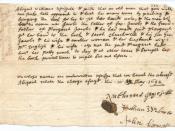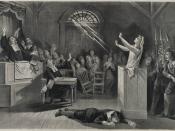In Arthur Miller's The Crucible, hysteria and its effects become the main focus of the story. To understand the ideas in Miller's play it is important to first know what hysteria is. By definition, hysteria is a state of intense agitation, anxiety, or excitement, especially when manifested by large groups or segments of society. It becomes apparent in Miller's story that hysteria was the catalyst for the nineteen deaths in the Salem Witch Trials of 1692. It is also important to understand that this tragic story of the past is retold with implications and criticisms of Miller's present time. Faced with the persecutions of the McCarthy era, Miller, through The Crucible, conveys an allegorical warning with a meaning for his time and times to come. Miller's story conveys how the effects of hysteria and paranoia can weaken and even destroy a society. Through his story Miller announces to the masses to keep Salem's history from repeating itself, to protest against McCarthyism, and to always denounce unjust persecution.
The Crucible begins when Reverend Samuel Parris finds his niece, Abigail Williams, his daughter, Betty, and his Barbados slave Tituba dancing "like heathen" in the forest. Problems arise when Betty and the other girls begin to become mysteriously ill. Rumors of witchcraft begin to fly when the illnesses can only be explained by "unnatural" causes. As the rumors spread about the devil, Abigail goes along with the charade and blames Tituba for forcing her to join the devil. Faced with execution Tituba has no choice but to confess her allegiance with Satan. She begins to accuse others of the same sending the town into a frenzy and massive witch-hunt causing many to be sent to jail and forced to either confess or to be hanged. In the midst of all the deception...


